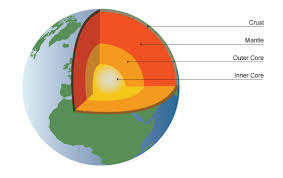Have you ever wondered what the inside of the earth is like?
Scientists had little knowledge of the interior of the earth but they gained a good understanding after they started to study earthquakes more closely. By examining these days and how they move through the earth, scientists are able to tell whether the inside of the earth solid or liquid. Besides studying the waves, scientists also rely on a lot of reasoning to come to a conclusion about the internal structure of the earth
Scientists go to know that there are three layers of the earth. First crust, second, mantle and the third, core.
The crust is the outermost layer of the earth. It varies in thickness from 5 to 60 kilometers. It is thin under the oceans and can be as thin as 5 kilometers. Under the continents, it can be as thick as 40 kilometres. The earth's crust is rigid and is broken into pieces called plates. The continental drift theory states that these plates are constantly moving.
Below the crust is the mantle. Is made up of denser rocks. It consists off semisolid rocks. the earth gets very hot as you get near its core. The mantle is thus heated up as it is right next to the core. As a result, convection currents are formed in the mantle. These currents flow from the lower part of the mantle and moves upwards.
The core is subdivided into the outer and inner cores. The outer core is made of extreamly dense liquid and is about 2250 kilometers thick. The most amazing thing is that the inner core is solid whereas the outer Core is liquid. In fact, the temperature is greater than 3700 Celsius at the core. Although the inner core is very hot, the pressure in there is to grade for melting to take place. The inner core is made up entirely of iron. The outer core is made up of nickel-iron alloy.

No comments:
Post a Comment